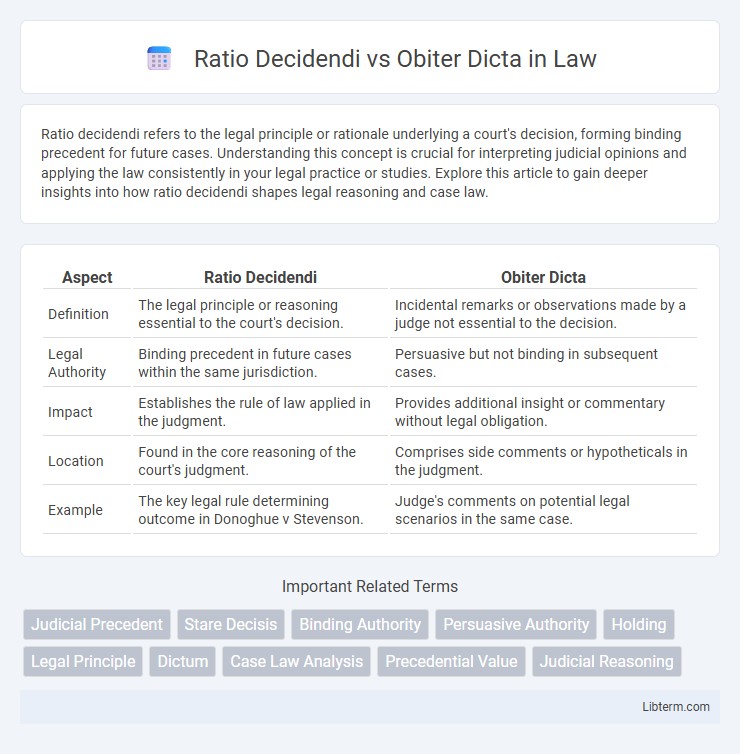Ratio decidendi refers to the legal principle or rationale underlying a court's decision, forming binding precedent for future cases. Understanding this concept is crucial for interpreting judicial opinions and applying the law consistently in your legal practice or studies. Explore this article to gain deeper insights into how ratio decidendi shapes legal reasoning and case law.
Table of Comparison
| Aspect | Ratio Decidendi | Obiter Dicta |
|---|---|---|
| Definition | The legal principle or reasoning essential to the court's decision. | Incidental remarks or observations made by a judge not essential to the decision. |
| Legal Authority | Binding precedent in future cases within the same jurisdiction. | Persuasive but not binding in subsequent cases. |
| Impact | Establishes the rule of law applied in the judgment. | Provides additional insight or commentary without legal obligation. |
| Location | Found in the core reasoning of the court's judgment. | Comprises side comments or hypotheticals in the judgment. |
| Example | The key legal rule determining outcome in Donoghue v Stevenson. | Judge's comments on potential legal scenarios in the same case. |
Introduction to Ratio Decidendi and Obiter Dicta
Ratio Decidendi refers to the legal principle or reason underlying a court's decision, forming the binding precedent in common law systems. Obiter Dicta consists of incidental remarks or observations made by judges that do not directly influence the case outcome and hold persuasive value only. Understanding the distinction between Ratio Decidendi and Obiter Dicta is crucial for legal interpretation and precedent application.
Defining Ratio Decidendi
Ratio decidendi refers to the legal principle or rule that forms the basis of a court's decision and is binding in future cases under the doctrine of precedent. It constitutes the essential reasoning necessary to reach the judgment, distinguishing it from obiter dicta, which are incidental remarks or observations made by judges that lack binding authority. Understanding the ratio decidendi is crucial for legal practitioners as it guides the application of law and ensures consistency in judicial decisions.
Understanding Obiter Dicta
Obiter dicta are statements made by a judge in a legal opinion that are not essential to the decision and do not have binding precedent, unlike the ratio decidendi which forms the core legal reasoning. Understanding obiter dicta is crucial as they provide persuasive guidance and insight into judicial thinking but lack authoritative power in subsequent cases. Legal professionals analyze obiter dicta to anticipate how courts might interpret the law beyond the binding ratio decidendi.
Key Differences Between Ratio Decidendi and Obiter Dicta
Ratio decidendi refers to the legal principle or rule that serves as the binding precedent in a judicial decision, forming the basis for future case law. Obiter dicta are incidental remarks or observations made by a judge that do not hold binding authority but may be persuasive in later cases. The key difference lies in their authoritative value: ratio decidendi is compulsory for lower courts to follow, whereas obiter dicta are non-binding and serve only as guidance or commentary.
Importance of Ratio Decidendi in Legal Precedent
Ratio decidendi constitutes the legal principle or rule essential to the court's decision and serves as binding precedent in common law systems. Its importance lies in guiding future judicial rulings by establishing authoritative legal standards, ensuring consistency and predictability in case law. Obiter dicta, while influential, lack this binding authority and function primarily as persuasive commentary or illustrative remarks.
The Role of Obiter Dicta in Judicial Decisions
Obiter dicta refer to statements or observations made by judges in judicial decisions that are not essential to the court's ruling and, therefore, lack binding precedent. Despite this, obiter dicta play a significant role in shaping legal reasoning, influencing future cases, and guiding lower courts by providing persuasive authority. These dicta often offer insight into a judge's interpretation of the law and can foreshadow potential shifts in legal principles or the expansion of existing doctrines.
Identifying Ratio Decidendi in Case Law
Ratio decidendi refers to the legal principle or rule essential to the court's decision in a case, forming binding precedent for future cases. Identifying the ratio decidendi involves analyzing the facts, issues, and the court's reasoning to distinguish the core rationale from obiter dicta, which are incidental remarks or observations not essential to the judgment. Accurate extraction of ratio decidendi ensures proper application of precedent and clarity in legal arguments.
Examples Illustrating Ratio Decidendi vs Obiter Dicta
In the landmark case of Donoghue v Stevenson [1932] AC 562, the ratio decidendi established the principle of the neighbor test in negligence, which directly influenced subsequent duty of care rulings. Contrastingly, the obiter dicta in this case involved comments on potential liability in cases of pure economic loss, which were not binding but persuasive in later judgments. Another example is R v Brown [1993] 2 All ER 75, where the ratio decidendi ruled consensual harm not to be a defense in assault cases, while obiter dicta explored hypothetical scenarios involving different types of consent, offering guidance without forming binding precedent.
Challenges in Distinguishing Ratio Decidendi from Obiter Dicta
Distinguishing ratio decidendi from obiter dicta poses significant challenges due to the complexity and variability of judicial opinions. Courts often issue rulings with intertwined legal principles and illustrative remarks, making it difficult to isolate the binding rationale that constitutes the ratio decidendi from non-binding observations or commentary classified as obiter dicta. This ambiguity complicates the application of precedent in common law systems, where accurate identification of ratio decidendi is critical for consistent and authoritative legal interpretation.
Significance of Both Concepts in Legal Practice
Ratio decidendi forms the binding precedent in legal practice, establishing the essential legal principles that courts must follow in future cases. Obiter dicta, while not legally binding, hold persuasive value and can influence judicial reasoning by providing context, opinions, or hypothetical scenarios. Understanding the distinction and significance of both concepts helps legal professionals accurately apply precedent and anticipate possible judicial interpretations.
Ratio Decidendi Infographic

 libterm.com
libterm.com